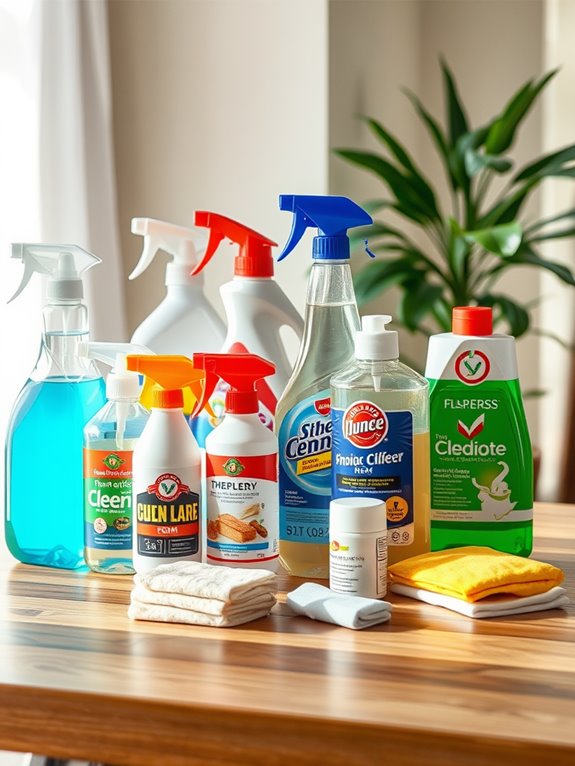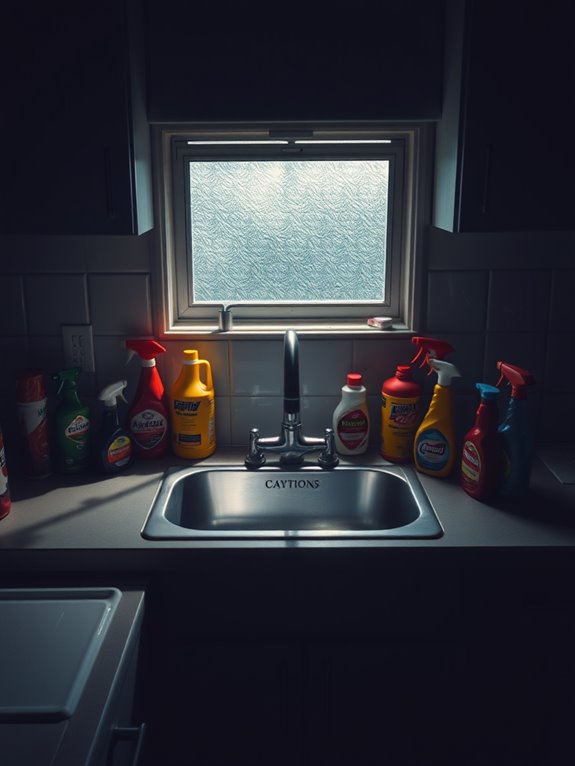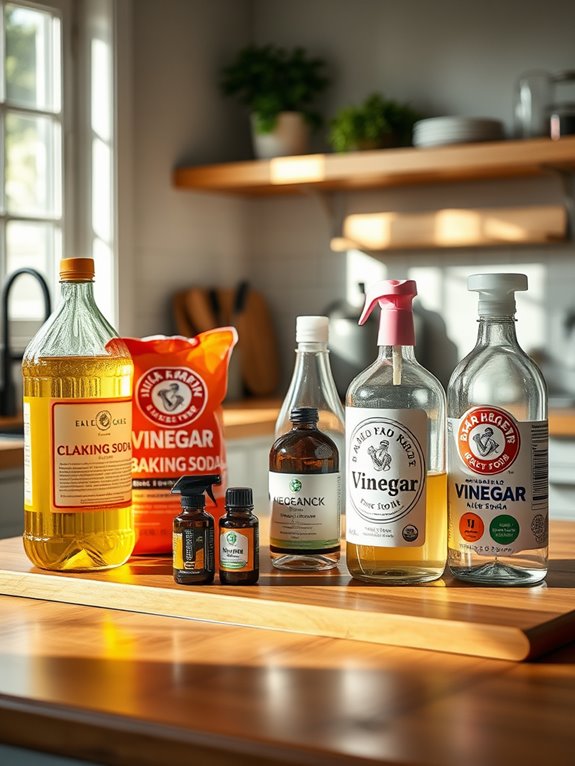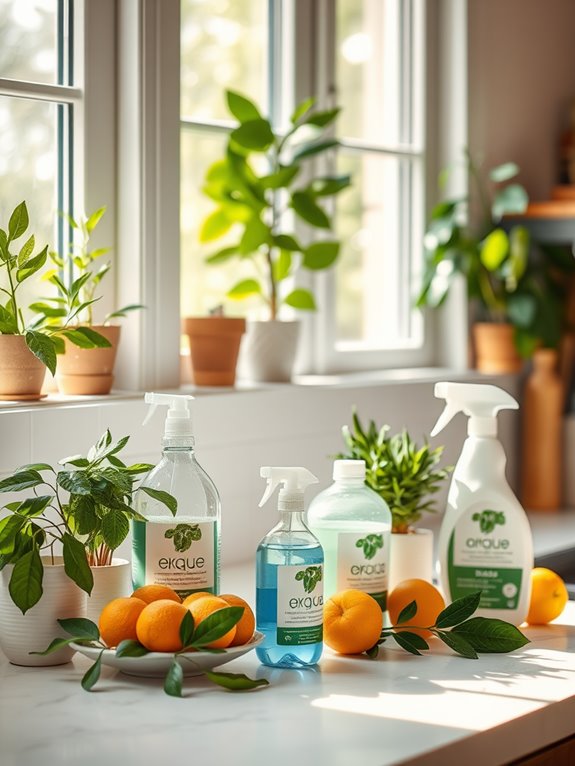Household cleaning products can be dangerous to your health and the environment due to harsh chemicals like ammonia and bleach. These substances can irritate your respiratory system, cause skin burns, and even disrupt hormones. With children or pets around, the risks increase considerably. Conventional cleaners also harm ecosystems and contribute to pollution. It's crucial to know how to use and store these products safely. Keep exploring to discover safer alternatives and tips for minimizing harmful exposure.
Understanding Household Cleaning Products

Household cleaning products are essential tools for maintaining a clean and healthy home, but understanding their ingredients is crucial for your safety.
You mightn't realize that some products contain harsh chemicals that can affect your health and the environment. Always read labels before using anything, and pay attention to warnings and safety instructions.
Consider the potential risks, especially if you have kids or pets. Opt for safer alternatives when possible, like eco-friendly or homemade options.
Common Ingredients in Cleaning Products
When you check your cleaning products, you might be surprised by the toxic chemicals lurking in them.
It's important to know what's in these products and consider safer, natural alternatives.
Understanding these ingredients can help you make better choices for your home and health.
Toxic Chemicals Overview
Many everyday cleaning products contain toxic chemicals that can pose serious health risks if not handled properly. It is crucial to know these common ingredients to protect yourself and your family. Here's a quick overview of some harmful chemicals found in cleaning products:
| Toxic Chemical | Potential Health Risks |
|---|---|
| Ammonia | Respiratory irritation, burns |
| Bleach | Skin irritation, respiratory issues |
| Phthalates | Hormonal disruption |
| Sodium hydroxide | Severe skin burns, eye damage |
| Triclosan | Antibiotic resistance, endocrine disruption |
Stay informed and choose wisely when selecting cleaning products for your home.
Natural Alternatives Available
If you're looking for safer alternatives to traditional cleaning products, you'll be pleased to know that plenty of natural ingredients can effectively tackle dirt and grime.
Vinegar is a powerful disinfectant that cuts through grease and odor. Baking soda works wonders as a gentle abrasive and deodorizer.
Lemon juice not only smells fresh but also has antibacterial properties. Essential oils like tea tree or lavender add antimicrobial benefits and pleasant scents.
Castile soap can replace harsh detergents in many cleaning applications.
Health Risks Associated With Cleaning Products

While you might rely on household cleaning products to keep your home fresh and tidy, it's essential to recognize the potential health risks they pose. Many common cleaning agents contain harsh chemicals that can lead to various health issues.
Here are some risks to bear in mind:
- Respiratory Problems: Inhalation of fumes can trigger asthma or exacerbate allergies.
- Skin Irritation: Direct contact can cause rashes or allergic reactions.
- Chemical Burns: Some products can lead to serious burns if mishandled.
- Long-term Effects: Prolonged exposure may increase the risk of chronic health conditions.
Stay informed and use products wisely!
Environmental Impact of Cleaning Products
Cleaning products not only affect your health but also have a significant impact on the environment. Many conventional cleaners contain chemicals that can pollute water supplies and harm aquatic life.
When these products enter your drains, they can disrupt ecosystems, leading to long-term damage. Additionally, the manufacturing and packaging processes of cleaning products contribute to air pollution and waste.
Safe Alternatives to Traditional Cleaning Products

Many people are unaware that safer alternatives to traditional cleaning products can effectively maintain a clean home without harming your health or the environment.
You can create your own cleaning solutions using simple ingredients. Here are four effective options:
- Vinegar: A natural disinfectant that cuts through grease and odors.
- Baking Soda: Excellent for scrubbing surfaces and deodorizing.
- Lemon Juice: Provides antibacterial properties and a fresh scent.
- Castile Soap: A versatile soap that can clean various surfaces safely.
Using these alternatives not only promotes a healthier home but also protects our planet.
Proper Usage and Storage of Cleaning Products
When using cleaning products, it's essential to follow the guidelines to guarantee safety for you, your kids, and your pets.
Proper storage practices can prevent accidents and keep harmful substances out of reach.
Safe Storage Practices
Although it might seem convenient to store cleaning products under the sink or in a closet, proper storage is vital for safety.
To keep your household safe, follow these storage practices:
- Keep out of reach: Store products in a high cabinet or locked area, away from children and pets.
- Original containers: Always leave products in their original containers to prevent mix-ups and guarantee proper labeling.
- Avoid heat and moisture: Store cleaning supplies in a cool, dry place to maintain their effectiveness.
- Regular checks: Periodically inspect and dispose of any expired or unused products responsibly.
Usage Guidelines and Precautions
Proper storage practices lay the groundwork for safe cleaning.
Always read the labels before using any cleaning product; this guarantees you're aware of the proper application methods and any necessary precautions.
Use gloves or masks if indicated, and make certain to work in a well-ventilated area to minimize inhalation of fumes.
Avoid mixing different cleaning products, as this can produce hazardous reactions.
When applying products, use only the recommended amount to avoid over-saturation and waste.
Finally, store all cleaning supplies out of reach of children and pets, guaranteeing they're tightly sealed in their original containers for safety.
Child and Pet Safety
Ensuring the safety of children and pets around cleaning products requires vigilance and thoughtful practices.
You can take simple steps to minimize risks:
- Store cleaning products in high, locked cabinets, out of reach of little hands and curious paws.
- Use child-resistant packaging whenever possible and check for safety seals.
- Always supervise areas where cleaning occurs, especially if using strong chemicals.
- Opt for non-toxic, eco-friendly cleaning solutions that are safer for your household.
Tips for Reducing Exposure to Harmful Chemicals

When it comes to keeping your home clean, you don't have to compromise your health; there are simple steps you can take to reduce your exposure to harmful chemicals. Start by using natural cleaning products, or make your own with ingredients like vinegar and baking soda. Always ventilate your space while cleaning and wear gloves to protect your skin. Check labels for harmful ingredients and opt for eco-friendly brands whenever possible.
| Action | Benefit | Example |
|---|---|---|
| Use natural cleaners | Fewer harmful chemicals | Vinegar, baking soda |
| Ventilate spaces | Improved air quality | Open windows |
| Wear gloves | Skin protection | Rubber or latex gloves |
Conclusion
To sum up, you can protect your health by choosing safer alternatives, minimize risks by using products as directed, and reduce environmental harm through responsible disposal. By being mindful of what you bring into your home, you're not just safeguarding your family but also contributing to a cleaner planet. Embrace natural options, practice proper storage, and stay informed about potential hazards. Your choices today can lead to a healthier tomorrow for you and the environment.

I’m Allen Kim, the chief editor of plumbinginto. I am a mid level plumber and assign to an local firm over 4 years of experience. During the working period, most of my experience is related to the house plumbing. I learned about the thing, when working with most experienced people in this sector, one must be as good as the inspector or better with knowledge of the project as well as the practical aspects of plumbing industry.